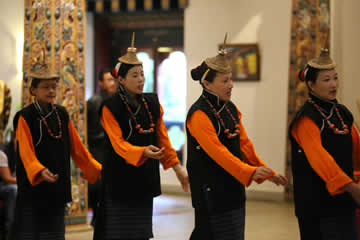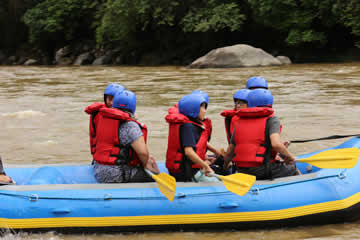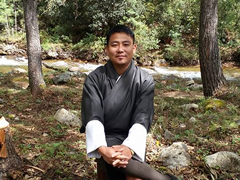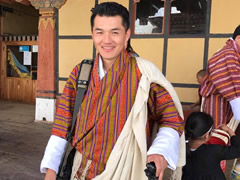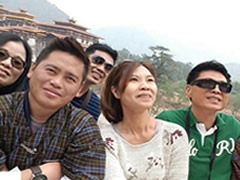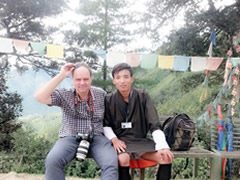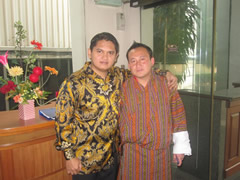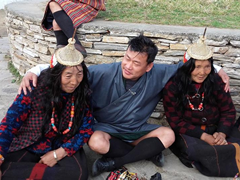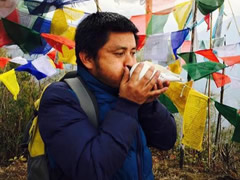Paro Dzong
Paro Dzong, also known as Rinpung Dzong meaning heap of a Jewel was built by Zhabdrung Ngawang Namgyal in the year 1646. During those times the dzongs were built mainly to protect from the Tibetan invaders and the story of the Paro Dzong began in the 15th century. During 15th Century there lived two brothers namely Gyalchog and Gyelzom who were the decedent of Phajo Drugom Zhigpo and they were the fedal lords in Paro . The elder brother Gyelchog went to study Theology (Study of the nature of God) in Tibet. He spent all his life time in studying without earning a penny.
 After completion of his studies he came back to Paro but his younger brother Gyelzom refused to invite his brother saying that he don’t have baggers at their families. Gyelchog the elder brother of Gyelzom start meditating near the Paro River.
After completion of his studies he came back to Paro but his younger brother Gyelzom refused to invite his brother saying that he don’t have baggers at their families. Gyelchog the elder brother of Gyelzom start meditating near the Paro River.
One day he was prophesied that if he go and mediate on the top of the hill where it looks like a heap of a jewel and there he will find his destiny. As prophesied he gained lots of power and followers. There one of his disciples built a five storied temple and offered to Gylechog as a token of gratitude and the temple was named as Hungrel. Even his younger brother, Gyelzom realize the mistake he has done and he apologize for the mistake and became the follower of Gyelchog.
During 17th century , after Zhabdrung Ngawang Namgyal unified Bhutan, Knowing the supernatural power of Zhabdrung , their decedent Pha drun drung offered the temple to Zhabdrung Ngawang Namgyal.
In 1644, Zhabdrung Ngawang Namgyal dismantled the Dzong and in the year 1646 he built the dzong into present structure.
At present day it functions as the district administrative office headed by the governer known as Dasho Dzongdag and the monastic body comprises of more than 200 monks headed by the Lam Neten equivalent to the Governor.
The importances of Paro Dzong are:
1. The wedding ceremony of the third king was held in Paro Dzong during 1951
2. The first national assembly was also held in Paro Dzong in the year 1953
3. The international movie/flim called ‘ Little Buddha ‘ was also shooed here in the year 1994
Paro National Museum
 National Musem of Bhutan was built in the year 1649 as watch tower to defense from the Tibetan Invaders to see the enemies coming. That’s why most of the watch towers are said to be built on the hills.
National Musem of Bhutan was built in the year 1649 as watch tower to defense from the Tibetan Invaders to see the enemies coming. That’s why most of the watch towers are said to be built on the hills.
Until 1965, the museum was almost into ruin, so third king of Bhutan has renovated and converted to national museum in the year 1968. It is of 6 storied high and considered to be one of the tallest building in the country.
It has many old and antique collections from all over Bhutan and was built in a conch shell with 2.5m-thick walls.
The museum is full of arts, handicrafts, paintings, stamps, statutes, textiles and mask.
Cameras are not allowed inside the museum, but you can photograph the Ta dzong and surrounding grounds. The museum closes an hour earlier in winter (November to February).
Unfortunately it was destroyed by earthquake until ground floor in the year 2011 and so the renovation is still going on. Meanwhile the Government of Bhutan has built the new block where we can still see few things now.
Paro Dungtse Lhakhang
Dungtse Lhakhang was constructed by the great bridge – builder Drupthop Thangthong Gyelpo in 1421 (some sources say 1433).
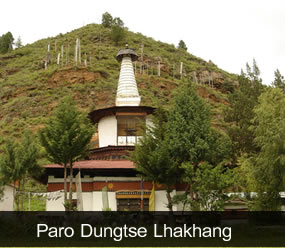 Thangthong Gyelpo means the king of open ground. Legend has it that he was conceived when a drop of rain entered a yak harder’s mouth. She was out casted by the locality and so she gave a birth to him in a large open field and she went back to her place. Fortunately he was found by the king and adopted as his son. He was a Buddhist scholar, architect, Physician, black smith and a civil engineer. He is known in Bhutan as Chagzampa ( which means iron bridge builder ). His visit to Bhutan was born from the invitation of the deities of the Paro and Ha valleys, Jowo Darkay and Ap Chundu.
Thangthong Gyelpo means the king of open ground. Legend has it that he was conceived when a drop of rain entered a yak harder’s mouth. She was out casted by the locality and so she gave a birth to him in a large open field and she went back to her place. Fortunately he was found by the king and adopted as his son. He was a Buddhist scholar, architect, Physician, black smith and a civil engineer. He is known in Bhutan as Chagzampa ( which means iron bridge builder ). His visit to Bhutan was born from the invitation of the deities of the Paro and Ha valleys, Jowo Darkay and Ap Chundu.
Back in the fourteen century, there was a nine headed frog at Jangsa, paro that spread the disease leprosy and bought suffering to the people. Upon the invitation by the people of jangsa, Thangthong Gyelpo subdued the demons and built the dungtse lhakhang. It is said to have built on the head of demoness who was causing illness to the inhabitants.
Dungtse lhakhang as its name suggested built in the shape of blowing horn. Its architecture is unique comparatively. It looks like a chorten / stupa and is three storied. The three represents the ground floor as a Naga / serpent realm, the middle floor as Human realm and the upper floor as Heaven realm.
The utse/ tower of the lhakhang is chained from all four directions because it is said that the utse attempt to fly to Tibet once.
Paro Kyichu Lhakhang
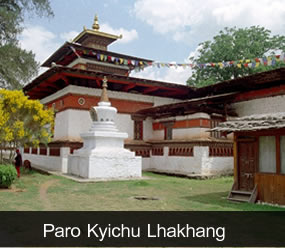 The Kichu Lhakhang can be reached from Paro town after a ten minute drive. It is located in the Lango Geog (county). The temple is undoubtedly one of the oldest temples to have been built in Bhutan. It is one of the 108 temples built by the Tibetan King Songtsen Gampo in the 7th century. The King is said to have built 108 temples in a day throughout the Himalayan regions. Of which Kichu Lhakhang in Paro and Jampa Lhakhang in Bumthang are two of them. Of the remaining temples most can be seen in Tibet.
The Kichu Lhakhang can be reached from Paro town after a ten minute drive. It is located in the Lango Geog (county). The temple is undoubtedly one of the oldest temples to have been built in Bhutan. It is one of the 108 temples built by the Tibetan King Songtsen Gampo in the 7th century. The King is said to have built 108 temples in a day throughout the Himalayan regions. Of which Kichu Lhakhang in Paro and Jampa Lhakhang in Bumthang are two of them. Of the remaining temples most can be seen in Tibet.
During the 7th Century there lived a Tibetan King known as Songtsen Gempo. He sent his wisest minister Lynpo Garab to compete for the hand of princes of China ‘ Azhi Jazo’ The princes was very beautiful and possess the every quality of dakiness. Her father wanted not a rich husband but the wise husband for his daughter.
So they held a big competition in china where people came from the four corners of the world to win her daughter Azhi Jazo. Among all the participants, Tibetan minister proofed to be the wisest. In a last task, all the competitors were asked to pass a thread from one end of the conch shell to another end. So the Tibetan ministers with his great idea tied the thread to an ant and send it through the hole. The ant successfully completes the threat passing from one end of the conch shell to another.
After winning the hand of princes the minister himself fallen in love with her. On their way back to Tibet, he delayed the journey by going to Tibet through Bhutan. They stopped at Kurtoe where the princes taught the art of weaving to the people of Kurote as a token of gratitude for their hospitality. They reached Tibet in three years’ time.
King Songtsen Gembo visited Tibet with his bride whereby Chinese King presented him with a small statute of the future Buddha (Joe Jamba). On their way back to Tibet , he dropped the statute along the way and could not pick it up even with his might and strength. On consulting the astrology he found out that the statute was pinned down by a huge demoness lying dormant across the Himalaya. If he was to retrieve the statute he has to build 108 lhakhangs or the temples in all her 108 joint on a single day.
Kichu Lhakhang is one of the 108 temples built by him throughout Tibet and the Himalayas to overcome a giant demoness. While Kyichu Lhakhang ( main statute : Joe Shakayamuni) was erected on the demoness’s left foot, and was one of the temples built ‘to subjugate regions beyond the frontiers’, Jampa Lhakhang ( main Statute Joe Jamba) was placed on the left knee and was one of the temples built ‘to subjugate the frontiers’.
Kichu Lhakhang was originally a small structure at the time of its establishment. Because of Jowo (Buddha) as the main statue the temple was also known as Jowo Lhakhang. Over the years the temple was visited and blessed by many famous Buddhist saints including Guru Rinpoche in the 8th century, one of the Lam Kha Nga – saints from five different schools that had their establishment in western Bhutan and the forerunner of the Drukpa Kagyu School in Bhutan, Lama Phajo Dugom Zhigpo also paid visit to the temple. It is said that, the temple was under the control of one of the five groups of lamas and it is likely that it was under the Barawa School. Later Lama Phajo is said to have stayed in the temple and took care of it as well. While most of the saints either meditated or preached doctrines and began to exercise their domain in the area, some of the saints actually contributed in extending the size of the temple from its original quaint structure to a more grandiose structure which can be seen today.
The latest extension was carried out in 1965 under the initiative of the Royal Queen Mother Ashi Kezang Choden Wangchuck. She added another new structure to the temple known as Guru Lhakhang.
As one of the oldest temples in Bhutan, the temple has many relics which date from the 7th century. The oldest of them are the statues of Lord Buddha Sakyamuni, and two of his disciples Maugalbu (Maudgalyana), Sharibu (Sariputra), other relics that has been added over time in the Jokhang are the four statues of Chagtong Chentong (The eleven headed one or Thousand arm-thousand eye one) installed by Dawa Penjor and Tshering Penjor during their tenure as the Penlop Rinpung Dzong.
Paro Takshang / Tiger Nest Monastery
Taktshang or the Tigers nest monastery is widely regarded as one of the most important monastery in Bhutan.The cave was named Taktshang after Guru Rinpoche flew into the cave from Kurtoe Singye Dzong in eastern Bhutan riding on a tigress. When landing within the cave he took the wrathful form of Guru Dorji Drolo (one of the eight manifestations of Guru Rinpoche) to subdue the demons. The monastery is one of the main thirteen Taktshangs as predicted to be built in the Buddhist world. Guru Rinpoche spent 4 months meditating in a cave and has subdued the local demon Singye Samdrup who brings suffering’s to the people and converted to the protector deities. Guru Rinpoche discovered 139 treasures of Vajrakilas which we can still see now but it can be shown only once in a year, i.e 30th day of 5th month of Bhutanese calendar. The cliff on which Taktshang stands is also supposed to resemble a ritual dagger – Phurpa (Vajrakila).r
It was not only a sacred site visited by Guru Rinpoche but was also visited and blessed by many others. The foremost being Langchen Pelgi Sengye, one of the 25 disciples of Guru Rinpoche who also named it as Pelphug (the cave of Pelgi). Langchen Pelgi Sengye went to Nepal after a spell of meditation in Taktshang and died there. However, Damchen Dorji Legpa (protective deity) brought back his kudung (bone relic), which is still preserved today. It is still believed that Langchen Pelgi Sengye on auspicious days pay visit to Taktshang and the chorten is considered to fulfil one’s wishes.
The site was visited by other Buddhist saints and masters including Milarepa, the cotton clad yogi and Phajo Dugom Zhigpo. Phajo Dugom Zhigpo supposedly meditated in Taktshang for about six months. While Phajo Dugom Zhigpo sat in meditation Guru Rinpoche is said to have appeared before him and handed over all his sacred places in Bhutan
The fourth Desi Tenzin Rabgay also visited the place and it was he who initially laid the foundation of the Takshang monastery under the command of Zhabdrung Ngawang Namgyel. However the walls constructed during day time were destroyed during night by the local demons which bring lots of problems while constructing the monastery. It is said that Tenzin Rabgay finally cut off his hair and mixed with the mud to be used in construction. After there were no more hindrance and completed the constructions smoothly.
Next to Taktshang is a waterfall known as Shelkar Zar. This is believed to be the Drupchu (holy water) of one hundred thousand dakinis. Beside the water fall is the main seat of Guru Rinpoche on a rock where he preached to his consort Khando Yeshey Tshogyal. As blessings he gave his crystal rosaries to Khando Yeshey Tshogyal and thereafter the area came to be known as Shelkar Zar.
On the left side of Shelkar Zar is a small meditation cave in which Khando Yeshey Tshogyal and Guru Rinpoche meditated. On it is a stone that resembles a lion’s face and the cave is known as Sengye Phug.
The main deity of Taktshang is Sengye Samdrup who appeared before Zhabdrung and handed over the Taktshang. He is considered to be one of the carpenters of Guru Rinpoche. At the time while Guru was constructing the Samye monastery in Tibet, he ordered Sengye Samdrup to design 108 large Dorji Phurpas (Vajrakila), 108 small Dorji Phurpas and 108 medium sized Dorji Phurpas. Later the remains of Langchen Pelgi Sengye were brought to Taktshang. He not only offered Taktshang under the care of Zhabdrung but later when Gyalse Tenzin Rabgye visited Taktshang, the deity appeared in his dreams and from this vision he pledged to be a monk and carry out any orders.
The monastery first burnt down in 1951. The fire was started accidentally by a woman from the nearby village known as Tsento Shari. While preparing her land for the next crop and burning the old stalks, the fire became uncontrollable and in the process reached Taktshang. The buildings that were burnt in the process were Shama Monastery, Ugyen Tsemo, Zangdopelri, Pelphug Dolo Monastery, Namsey, Tshepagmed Monastery and the deity’s temple. The temples that were unscathed by fire were Guru Tshengyad (eight manifestations of Guru Rinpoche) Monastery, Guru Sung Jonmai Monastery, Kilkhor Monastery, Chorten Monastery, Kunray (assembly hall for monks) and the caretakers house. While the other buildings were being raised by the fire, the relics that were not burnt were the Khathrab (statue of deity), the Tsen dar (flag of deity) and the seven water offering bowls.
During the reign of King Jigme Wangchuck he ordered the entire population of Tsento village to rebuild the four temples of Taktshang as they did not participate in controlling the fire. This was a sort of punishment meted out to the Tsentops. The Shama Monastery was built by the Drugyal Dzongpon Jangsarp. The lady who was responsible for the fire was ordered to rebuild the Zangdopelri Monastery. Ugyen Tsemo was rebuilt by the Taktshang Lama Khagorp (Kha sgorp). And in 1954 at the order of the Queen Mother Ashi Phuntsho Choden, Ugyen Tsemo Monastery was rebuilt by Je Khenpo Tenzin Dendup and Phub Dorji.
In recent years the monastery was burnt on the 19th day of the 4th month in 1998. The government undertook the reconstruction in 2000 and the project was completed and consecrated. The main temples today are Druphu Nye, Guru Sung Jon mai Monastery (monastery which house the statue of Guru, who spoke),Kunrey Monastery (monastery, where monks assemble), Chorten Monastery, Guru Tshengyad Monastery (Monastery which house the Statue of Guru in eight forms), Drolo Monastery (Monastery of crazy wisdom Vajra), Namsey Monastery (monastery of Kuvera), Tshepamed Monastery (monastery of Bodhisattva of Long life), Naypoi Monastery (monastery of deity) and Marmi Dagsum Monastery.
Briefing to the Guest on visiting Tiger nest
Tomorrow we are going to visit Tiger nest which is of 3000 meter high above the sea level and it will take us about 20 minutes ride from the hotel and from there (base) we have to hike about 2 to 3 hours at the max depending upon your stamina, but the trails are very wide and big enough with sub trails along the way which will take you to tiger nest as well but I encourage you to take the wider trails for your convenient.
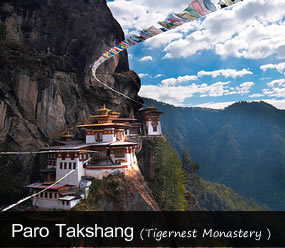 After one hour hike , we will reach to cafeteria where we shall stop for the tea and use the toilet facilities and if you think you cannot walk up again, please do not push up yourself but you can relax and see the tiger nest close enough from the cafeteria and those who still want to go further it will take another 1 and half hour to reach our destinations.
After one hour hike , we will reach to cafeteria where we shall stop for the tea and use the toilet facilities and if you think you cannot walk up again, please do not push up yourself but you can relax and see the tiger nest close enough from the cafeteria and those who still want to go further it will take another 1 and half hour to reach our destinations.
As a reminder, please refrain from walking through the middle of the trail because the horses coming down may hit you due to steepness.
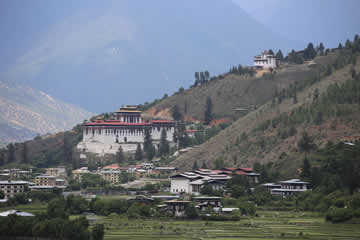 This beautiful Paro valley is about 2000 m above the sea level. Paro is believed to be one of the first valleys to have received the influences of the Buddhism.It is the site of the country’s only international airport and is also known for the many sacred sites in the area. North of town, the Taktsang Palphug (Tiger’s Nest) monastery clings to cliffs above the forested Paro Valley. Northwest of here are the remains of a defensive fortress, Drukgyel Dzong, dating from the 17th century.
This beautiful Paro valley is about 2000 m above the sea level. Paro is believed to be one of the first valleys to have received the influences of the Buddhism.It is the site of the country’s only international airport and is also known for the many sacred sites in the area. North of town, the Taktsang Palphug (Tiger’s Nest) monastery clings to cliffs above the forested Paro Valley. Northwest of here are the remains of a defensive fortress, Drukgyel Dzong, dating from the 17th century.  After completion of his studies he came back to Paro but his younger brother Gyelzom refused to invite his brother saying that he don’t have baggers at their families. Gyelchog the elder brother of Gyelzom start meditating near the Paro River.
After completion of his studies he came back to Paro but his younger brother Gyelzom refused to invite his brother saying that he don’t have baggers at their families. Gyelchog the elder brother of Gyelzom start meditating near the Paro River. National Musem of Bhutan was built in the year 1649 as watch tower to defense from the Tibetan Invaders to see the enemies coming. That’s why most of the watch towers are said to be built on the hills.
National Musem of Bhutan was built in the year 1649 as watch tower to defense from the Tibetan Invaders to see the enemies coming. That’s why most of the watch towers are said to be built on the hills. Thangthong Gyelpo means the king of open ground. Legend has it that he was conceived when a drop of rain entered a yak harder’s mouth. She was out casted by the locality and so she gave a birth to him in a large open field and she went back to her place. Fortunately he was found by the king and adopted as his son. He was a Buddhist scholar, architect, Physician, black smith and a civil engineer. He is known in Bhutan as Chagzampa ( which means iron bridge builder ). His visit to Bhutan was born from the invitation of the deities of the Paro and Ha valleys, Jowo Darkay and Ap Chundu.
Thangthong Gyelpo means the king of open ground. Legend has it that he was conceived when a drop of rain entered a yak harder’s mouth. She was out casted by the locality and so she gave a birth to him in a large open field and she went back to her place. Fortunately he was found by the king and adopted as his son. He was a Buddhist scholar, architect, Physician, black smith and a civil engineer. He is known in Bhutan as Chagzampa ( which means iron bridge builder ). His visit to Bhutan was born from the invitation of the deities of the Paro and Ha valleys, Jowo Darkay and Ap Chundu. The Kichu Lhakhang can be reached from Paro town after a ten minute drive. It is located in the Lango Geog (county). The temple is undoubtedly one of the oldest temples to have been built in Bhutan. It is one of the 108 temples built by the Tibetan King Songtsen Gampo in the 7th century. The King is said to have built 108 temples in a day throughout the Himalayan regions. Of which Kichu Lhakhang in Paro and Jampa Lhakhang in Bumthang are two of them. Of the remaining temples most can be seen in Tibet.
The Kichu Lhakhang can be reached from Paro town after a ten minute drive. It is located in the Lango Geog (county). The temple is undoubtedly one of the oldest temples to have been built in Bhutan. It is one of the 108 temples built by the Tibetan King Songtsen Gampo in the 7th century. The King is said to have built 108 temples in a day throughout the Himalayan regions. Of which Kichu Lhakhang in Paro and Jampa Lhakhang in Bumthang are two of them. Of the remaining temples most can be seen in Tibet. After one hour hike , we will reach to cafeteria where we shall stop for the tea and use the toilet facilities and if you think you cannot walk up again, please do not push up yourself but you can relax and see the tiger nest close enough from the cafeteria and those who still want to go further it will take another 1 and half hour to reach our destinations.
After one hour hike , we will reach to cafeteria where we shall stop for the tea and use the toilet facilities and if you think you cannot walk up again, please do not push up yourself but you can relax and see the tiger nest close enough from the cafeteria and those who still want to go further it will take another 1 and half hour to reach our destinations.

